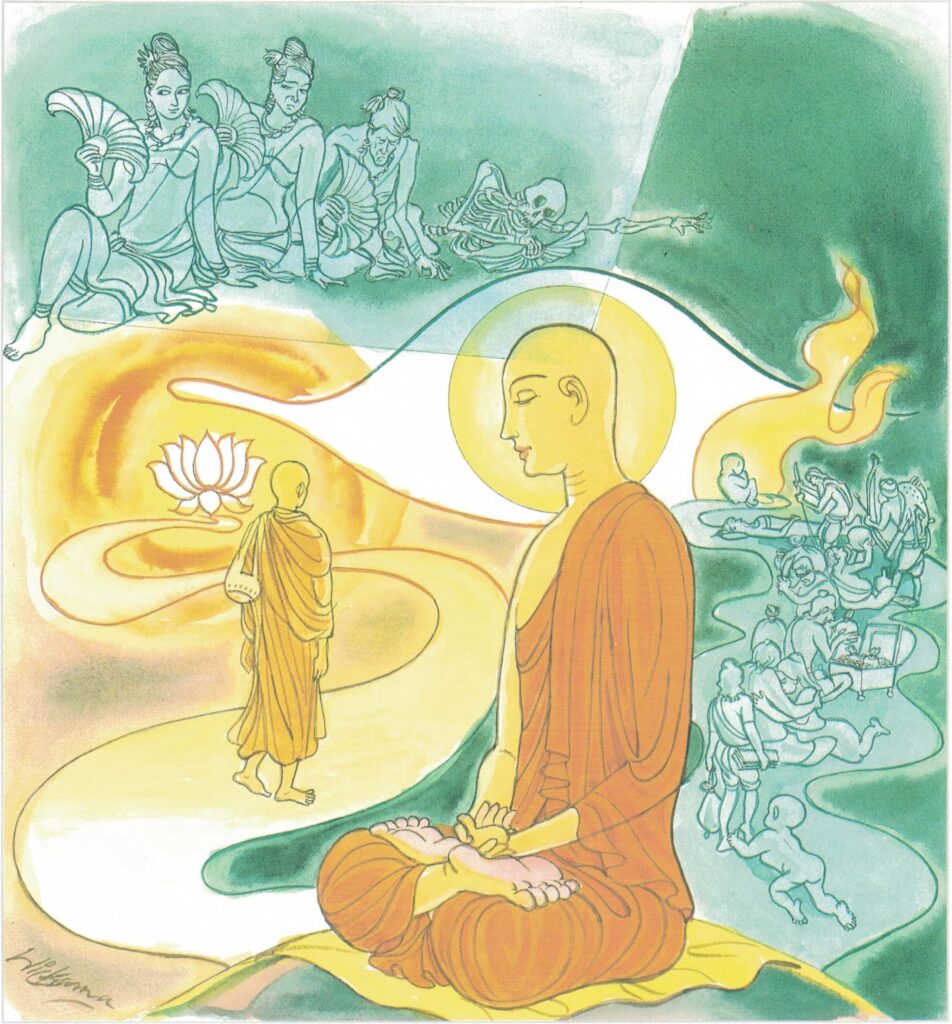Pali text, illustration and English translation of Dhammapada verse 403:
gambhīrapaññaṃ medhāviṃ maggāmaggassa kovidaṃ |
uttama’tthaṃ anuppattaṃ tam ahaṃ brūmi brāhmaṇaṃ || 403 ||
403. Whose knowledge is deep, who’s wise, who’s skilled in ways right and wrong, having attained the highest aim, that one I call a Brahmin True.

Khemā the Wise
This religious instruction was given by the Buddha while He was in residence on Mount Vulture Peak, with reference to the nun Khemā.
For one day, immediately after the first watch, Sakka, king of gods, came with his retinue of deities, sat down, and listened to the Buddha as he discoursed in his usual pleasant manner on the Dhamma. At that moment the nun Khemā said to herself, I will go see the Buddha,” and drew near to the presence of the Buddha. But when she saw Sakka, she saluted the Buddha, poised in the air as she was, turned around, and departed. Sakka saw her and asked the Buddha, “Who was that, Venerable, that drew near to your presence, and then, poised in the air as she was, saluted you and turned around and departed?” The Buddha replied, “That, great king, was my daughter Khīmā, possessed of great wisdom, knowing well what is the path and what is not the path.”
Explanatory Translation (Verse 403)
gambhīrapaññaṃ medhāviṃ maggāmaggaṃ kovidaṃ
uttamatthaṃ anuppattaṃ taṃ ahaṃ brāhmaṇaṃ brūmi
gambhīrapaññaṃ [gambhīrapañña]: of deep wisdom; medhāviṃ [medhāvi]: full of insight; maggāmaggaṃ [maggāmagga]: discriminating the right and the wrong paths; kovidaṃ [kovida]: capable of, uttamatthaṃ [uttamattha]: highest state; anuppattaṃ (who has) reached; taṃ: him; ahaṃ: I; brāhmaṇaṃ [brāhmaṇa]: a brāhmaṇa; brūmi: declare
He possesses profound wisdom. He is full of insight. He is capable of discriminating the right path from the wrong path. He has reached the highest state. I call that person a true brāhmaṇa.
Commentary and exegetical material (Verse 403)
The story of Khemā: Khemā was born in a princely family at Sāgala by the name of Khemā. The colour of her complexion was that of gold. She was beautiful. She married King Bimbisāra of Kosala. She was reluctant, however, to visit the Buddha, for fear that the Blessed One would moralise on the fleeting nature of beauty.
Every time she visited the temple she dodged the Buddha. One day the king got his men to take her willy-nilly to the Buddha. On her arrival, the Buddha created a phantom of unsurpassing beauty to attend on Him. Khemā was struck by her beauty. While she was thus engaged she felt that beauty could only beguile. The Buddha made the figure to go through youth middle age, old age and thereafter to extreme old age devoid of everything worthwhile. Beauty thus gave way to hideousness. It was a graphic picture. Khemā understood the meaning and felt what was in store for her. Anicca, dukkha and anatta: in other words, transiency and sorrow–without any lasting entity called a soul.
To a mind thus prepared the Buddha preached. The seeds fell on good ground. She entered the stream of sainthood (sotāpanna). The Buddha illustrated His sermon by bringing before her mind the lesson of the spider and the web. As soon as a fly strikes a web, the spider by the motion thus generated takes it as a signal and attacks and devours the fly. This goes on. The spider becomes wedded to the web. So are human beings wedded to passion and lust. Her mind saw all. She became an arahat. She asked permission from the king for her ordination. The king, himself a budding saint, readily consented. One day god Māra, in the guise of a young man, tempted Khemā. The man met with a rebuff. His discomfiture was complete. He took to flight. One night Khemā thought of visiting the Buddha. But the Buddha was with Sakka, king of the deities. Rather than disturb the Buddha, Khemā wheeled round in the air and disappeared.
Sakka, on seeing the vision, was soon enlightened on the matter by the Buddha. The Buddha, addressing the monks and the laity, declared Khemā was, among the female disciples, the most eminent in wisdom.